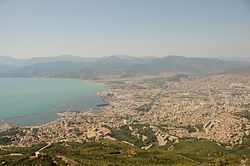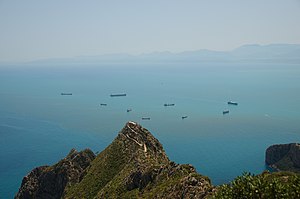Béjaïa | |
|---|---|
Commune and town | |
 | |
| Nickname(s): Vgaiet,Bougie | |
| Country | |
| Province | Béjaïa Province |
| Government | |
| • Mayor | Hannache Tahar (2008-2012) |
| Area | |
| • Total | 3,268.26 km2 (1,261.88 sq mi) |
| Population (2004) | |
| • Total | 187,076 |
| • Density | 57/km2 (150/sq mi) |
| Time zone | UTC+1 (CET) |
Béjaïa, Vgaiet or Bejaya (Tifinagh: ![]() , Arabic: بجاية) is a Mediterranean port in Algeria on the Gulf of Béjaïa, capital of Béjaïa Province, Kabylia. Under French rule, it was formerly known under various European names, such as Budschaja in German, Bugia in Italian, and Bougie [buˈʒi] (both of which are words for 'candle'). Béjaïa is the largest city in Kabylia (second largest is Tizi Ouzou), and one of the largest principally Berber speaking cities.
, Arabic: بجاية) is a Mediterranean port in Algeria on the Gulf of Béjaïa, capital of Béjaïa Province, Kabylia. Under French rule, it was formerly known under various European names, such as Budschaja in German, Bugia in Italian, and Bougie [buˈʒi] (both of which are words for 'candle'). Béjaïa is the largest city in Kabylia (second largest is Tizi Ouzou), and one of the largest principally Berber speaking cities.
Geography
The town is overlooked by the mountain Yemma Gouraya, whose profile is said to resemble a sleeping woman; other nearby scenic spots include the Aiguades beach and the Pic des Singes (Monkey Peak); the latter site is a habitat for the endangered Barbary Macaque, Macaca sylvanus, which prehistorically had a much broader distribution than at present. All three of these geographic features are contained in the Gouraya National Park. The Soummam river runs past the town.
History
Bejaia was first inhabited by Numidian Berbers. A minor port in Carthaginian and Roman times, Béjaïa was the Roman Saldae, a veteran colony founded by emperor Vespasian of great importance in the province of Mauretania Caesariensis, later in the fraction Sitifensis.
In the second or third century AD, Gaius Cornelius Peregrinus, a decurion (town councillor) from Saldae was a tribunus (military commander) of the auxiliary garrison at Alauna Carvetiorum in northern Britain. An altar dedicated to him was discovered shortly before 1587 in the north-west corner of the fort, where it had probably been re-used in a late-Roman building (source).
It became the capital of the short-lived African kingdom of the Germanic Vandals (founded in 429-430), which was wiped out circa 533 by the Byzantines who established the African prefecture and later the Exarchate of Carthage. It had disappeared but was refounded by the Berber Hammadid dynasty (whose capital it became) in the 11th century, and became an important port and cultural center. As a principal town of the Hammadid leader, Emir En Nasser, Béjaïa flourished and was renamed En Nassria. En Nasser's son, el Mansour, built an impressive palace inside the fortifications constructed by his father. The Hammadid Empire fell in 1152, when the Almohad ruler, Abd al-Mu'min, invaded central Maghreb from Morocco.[1] The son of a Pisan merchant (and probably consul), posthumously known as Fibonacci, there learned under the Almohad dynasty about Arabic numerals, and introduced them and modern mathematics into feudal Europe.

In the 13th century Béjaïa was acquired by the Hafsid Empire when the dynasty took control of Tunis. Pirates were active along the Barbary Coast starting in the 16th century.[1]
After a Spanish occupation (1510–55), the city was taken by the Ottoman Turks in the Capture of Bougie in 1555. Until it was captured by the French in 1833, Béjaïa was a stronghold of the Barbary pirates (see Barbary States).
It was Christianized in the 5th century, became officially Arian under the Vandals, and then Muslim under the Berbers. City landmarks include a 16th-century mosque and a casbah (fortress) built by the Spanish in 1545.
In the museum of Béjaïa can be seen a picture of Orientalist painter Maurice Boitel, who painted in the city for a while.
Demography
The population of the city in 2005 was 187,076, while the population of the whole wilaya (province) was 905,000.[2]
| Year | Population | Year | Population |
|---|---|---|---|
| 1901 | 14,600 | 1954 | 43,900 |
| 1906 | 17,500 | 1960 | 63,000 |
| 1911 | 10,000 | 1966 | 49,900 |
| 1921 | 19,400 | 1974 | 104,000 |
| 1926 | 15,900 | 1977 | 74,000 (town) 89,500 (municipality) |
| 1931 | 25,300 | 1987 | 114,500 |
| 1936 | 30,700 | 1998 | 144,400 |
| 1948 | 28,500 |
Economy
The northern terminus of the Hassi Messaoud oil pipeline from the Sahara, Béjaïa is the principal oil port of the Western Mediterranean. Exports, aside from crude petroleum, include iron, phosphates, wines, dried figs, and plums. The city also has textile and cork industries.
Friendly relationship

Béjaïa has an official friendly relationship (protocole d'amitié) with:[4]
 Brest, France, since 1995
Brest, France, since 1995
References
- ↑ 1.0 1.1 Bejaia & the Corniche Kabyle, Morocco, Algeria & Tunisia: a travel survival kit, Geoff Crowther & Hugh Finlay, Lonely Planet, 2nd Edition, April 1992, p. 292.
- ↑ http://www.wbejaia.gov.dz/population.htm
- ↑ populstat.info
- ↑ Les jumelages de Brest
External links
 Media related to Béjaïa at Wikimedia Commons
Media related to Béjaïa at Wikimedia Commons- (French) Bgayet.Net
- (French) History of Béjaïa
- Google map of Béjaïa
Lua error in package.lua at line 80: module 'strict' not found.
ar:بجاية an:Bochía bg:Бежая ca:Bejaïa da:Béjaïa de:Bejaia et:Bejaïa es:Bugía fr:Béjaïa it:Béjaïa la:Saldae lt:Bedžaja mk:Беџаја nl:Béjaïa (stad) ja:ベジャイア no:Béjaïa pl:Bidżaja pt:Bugia (Argélia) ro:Béjaïa ru:Беджая scn:Béjaïa fi:Bejaïa sv:Béjaïa kab:Bgayet war:Béjaïa zh:贝贾亚
- Pages using duplicate arguments in template calls
- Pages with script errors
- Articles with short description
- Pages using infobox settlement with possible nickname list
- Pages using infobox settlement with unknown parameters
- Articles with French-language external links
- Communes of Algeria
- Former Spanish colonies
- Kabylie
- Populated places in Béjaïa Province


